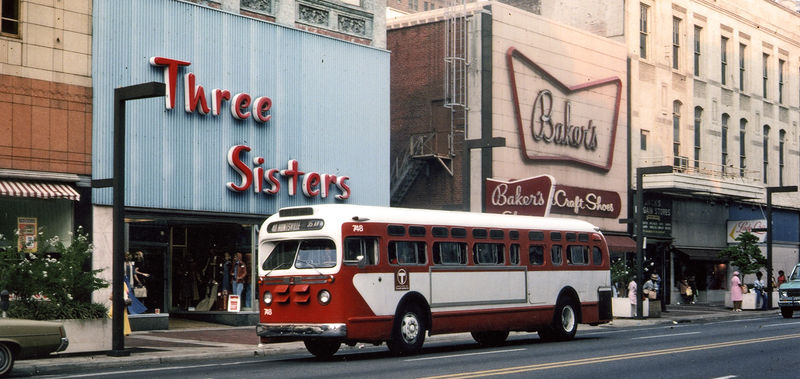Birmingham Transit Company
The Birmingham Transit Company was the successor to the transportation division of the Birmingham Railway & Electric Company (BREC). Active from 1951 to 1972, BTC is notable for having overseen the transition from streetcars to buses in the 1950s.
Immediately following World War II, with ridership peaking at about 90 million passenger trips per year, BREC changed its name to the Birmingham Electric Company and made plans to modernize its rolling stock. It selected a streamlined modern car design developed by the Electric Railway Presidents' Conference Committee and manufactured by Pullman Standard. Birmingham's order of 47 "PCC" streetcars was delivered in 1947 along with a fleet of matching "trackless trolley" buses. The modernization campaign stalled short of replacing the entire fleet and some streetcar lines set for replacement by buses continued to operate with a mix of old and new railcars. In 1950 BEC was granted a long sought-after fare increase to 10 cents.
In 1951 BEC merged its power-generating and distribution arm with Alabama Power Company, and put its transportation business up for sale. No bids were received in response to the initial offering, but eventually a group of local investors acquired the company at a bargain price. N. H. Hawkins, Jr was president of the company. By 1953 increased fares and independence from the electric utility prompted the company to resume its modernization program. It quickly abandoned all routes not served by the new cars and upgraded passenger facilities on the remaining express routes.
The City of Birmingham, however, began to actively lobby for the removal of all streetcars in the early 1950s. The railcars were blamed for causing traffic congestion and compromising safety. City officials threatened to revoke the company's operating license unless the cars were removed from the streets. In 1953 BTC sold its remaining fleet of nearly-new streetcars to the Toronto Transit Commission and replaced all lines with buses. Birmingham's final streetcar route was run from Ensley on April 19, 1953, operated by 36-year veteran G. H. Averitt. The trackage was removed or covered up by the end of August of that year, with the exception of one dump car line, used by Alabama Power at its Powell Avenue Steam Plant, which remained in service over a short section of track until 1955.
The electric trackless trolleys, which still drew power from overhead lines, remained in limited service until 1958. Most of that equipment was sold to Mexico City, Mexico and Vancouver, Canada. The 4th Avenue Barn, the center of Birmingham's street rail system, was demolished for construction of I-65.
The transit company was acquired by John S. Jemison & Co. in 1958. Later that year, stricter segregation laws were enacted by the City of Birmingham, empowering BTC to regulate seating on its conveyances and defining any refusal to obey operators' instructions as a "breach of the peace". Attempts by the Alabama Christian Movement for Human Rights to stage a bus boycott were never as successful as those in Montgomery, a much more compact city where riders could more easily walk or arrange for carpools.
In 1971 the Alabama legislature passed a law enabling the formation of public transit authorities to administer local and federal funds for transportation. The Birmingham Jefferson County Transit Authority was formed in 1972 and took over operations of buses in the Birmingham area.
Streetcar lines
When the Birmingham Transit Company was created in 1951, only seven streetcar lines remained in service:
- BTC Route 1 (Bessemer), served by older cars, abandoned by 1952
- BTC Route 2 (West End), served by PCC cars, abandoned in 1953
- BTC Route 3 (Wenonah), served by older cars, abandoned by 1952
- BTC Route 4 (Bessemer), served by older cars, abandoned by 1952
- BTC Route 25 (Center Point), served by PCC cars, abandoned in 1953
- BTC Route 27 (Ensley), served by PCC cars, abandoned in 1953
- BTC Route 38 (East Lake), served by PCC cars, abandoned in 1953
References
- Hudson, Alvin W. & Harold E. Cox (1976) Street Railways of Birmingham. Forty Fort, Pennsylvania: Harold E. Cox
- Wilson, Bobby M. (2000) Race and Place in Birmingham: The Civil Rights and Neighborhood Movements. Lanham, Maryland: Rowman & Littlefield. ISBN 0847694836
External links
- San Francisco streetcar in Birmingham Electric livery:

